Gennaro Cuofano's Blog, page 195
September 25, 2020
What Is Poka-yoke And Why It Matters In Business
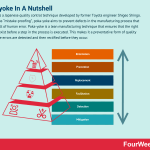
Poka-yoke is a Japanese quality control technique developed by former Toyota engineer Shigeo Shingo. Translated as “mistake-proofing”, poka-yoke aims to prevent defects in the manufacturing process that are the result of human error. Poka-yoke is a lean manufacturing technique that ensures that the right conditions exist before a step in the process is executed. This makes it a preventative form of quality control since errors are detected and then rectified before they occur.
Understanding poka-yoke
Some process errors cannot be detected ahead of time. In this case, the poka-yoke technique seeks to eliminate errors as early on in the process as is feasible.
Although the poka-yoke technique became a key part of Toyota’s manufacturing process, it can be applied to any industry or indeed any situation where there is potential for human error.
One of the most well-known examples of poka-yoke in action is in the case of a manual automobile. The driver must engage the clutch (a process step) before changing gears. This prevents unintended movement of the car and reduces wear on the engine and gearbox.
Another example can be found in washing machines, which do not operate if the door isn’t closed properly to prevent flooding. In both cases, poka-yoke principles mean that automation is in place to prevent errors before they occur.
The six principles of poka-yoke
To reduce the prevalence of process errors, poka-yoke is based on six principles in decreasing order of effectiveness.
Elimination – the most preferable solution. It involves redesigning a product or process so that a particular step is no longer necessary.Prevention – or engineering a product or service so that it is virtually impossible for an individual to make a mistake.Replacement – can a more reliable process be substituted in to lessen the chances of an error occurring?Facilitation – or the adoption of techniques to make a task easier to perform. This may involve combining certain steps.Detection – or identifying an error before further process steps are undertaken. This allows the error to be rectified without further damage to equipment or personnel.Mitigation – the least preferable solution. Here, the aim is to minimize the effects of errors without necessarily solving them.
Benefits of poka-yoke principles for businesses
Error prevention is an obvious advantage to poka-yoke, but what positive ramifications does error prevention have for business?
Improved profitability
Errors on production lines decrease profitability – whether that be through line shutdowns or expensive worker injuries. But poka-yoke principles improve a company’s bottom line in other ways.
For example, hotels now require that guests insert their key-card into a slot to activate electricity in their room. Since many guests do not bother to turn the lights off after they leave, the hotel can save money on wasted electricity consumption.
Improved productivity
Preventing errors before they occur increases productivity. Online forms require that every field be filled out before submission. This reduces errors in forms resulting from incomplete or missing information, saving the company time and money in having to chase up consumers for the extra details.
ATMs also chime or flash to remind the customer to retrieve their debit card and cash. This greatly reduces the once common error of customers leaving their cards in the machine. It also saves the bank money in loss prevention, giving customer support the resources to deal with other problems.
Simplification of smaller, error-prone tasks
Small tasks with high probability of error are particularly prevalent in some industries such as the service and hospitality industries. Cashier errors in counting change, for example, are relatively inconsequential errors in isolation that have the potential to lose a business a lot of money over the long term.
To this end, poka-yoke principles have automated the change counting process and where automation is not possible, digital interfaces verify that the cashier has given the correct amount of change. Similar systems are now in place to prevent errors in order fulfillment and delivery of orders to a table.
Key takeaways:
Poka-yoke is a Japanese quality control technique that aims to make processes error-proof.Although having origins in the manufacturing industry, poka-yoke principles are useful in any scenario where there is potential for human error.Poka-yoke error prevention is guided by six principles, with elimination the most desirable and mitigation the least desirable. All six principles can nevertheless improve productivity, profitability, and simplify smaller, error-prone manual tasks.
Other strategy frameworks:
AIDA ModelAnsoff MatrixBalanced ScorecardBCG MatrixDesign ThinkingFlywheelLean Startup CanvasOKRPestel AnalysisTechnology Adoption CurveTotal Addressable Market
Additional resources:
Market SegmentationSuccessful Types of Business Models You Need to KnowThe Complete Guide To Business DevelopmentBusiness Strategy: Definition, Examples, And Case StudiesWhat Is a Value Proposition? Value Proposition Canvas ExplainedMarketing Strategy: Definition, Types, And Examples
The post What Is Poka-yoke And Why It Matters In Business appeared first on FourWeekMBA.
Value Stream Mapping And Why It Matters In Business
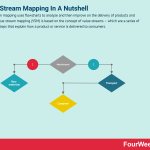
Value stream mapping uses flowcharts to analyze and then improve on the delivery of products and services. Value stream mapping (VSM) is based on the concept of value streams – which are a series of sequential steps that explain how a product or service is delivered to consumers.
Understanding value stream mapping
Value stream mapping enables businesses to analyze each step and whether it is adding value. Importantly, value stream mapping also allows intelligent, holistic refinement of the whole process. In other words, it assigns value to a step on the condition that the value it obtains does not come at the expense of another step.
All VSM initiatives have start and end points known as fenceposts, which differ according to predetermined goals and objectives. As a result, VSM can be utilized for any individual product or service for any type of business.
For example, the process of a car dealership delivering a new car to a customer might have 35 steps. After mapping out the process using VSM, company executives found that only 10 added any real value to the consumer. By focusing on the 10 steps in more deal, the dealership was able to streamline its delivery process and reduce consumer wait times.
Three components of every value stream map
Each map typically consists of three sections:
Information flow. This component illustrates the communication of information or the transmission of data crucial to the process. In the case of the car dealership, a sales manager may accept applications for financing and then forward approved requests to the finance company.Product flow. This component documents the steps required to take a product or service from concept to delivery. However, value stream mapping can also be used to “zoom in” on particular steps of the product development process. Indeed, there is no limit on the level of detail that can be analyzed for each step.Time ladder. Although rather simplistic, the time ladder provides a visual representation of the value stream timeline. Time ladders denote the time that a product spends on each step, known as the process time. They also denote waiting time, or the amount of time a product has to wait before proceeding to the next step. Ultimately, both are used in the calculation of lead time – or the total amount of time it takes between receiving a consumer order and the fulfillment of that order.
Advantages and disadvantages of value stream mapping
Advantages
Value stream mapping is still relatively new in the business world, so there is potential that early adopters gain a competitive advantage.
It’s also a powerful method for identifying wastage in a process. Wastage often refers to manufacturing, but in VSM it more generally refers to any step that does not add value to the consumer. With a focus on providing consumer value, the business can align with its core values and brand identity. Value is of course something that consumers are willing to pay for, so businesses should utilize the incremental improvement capability of VSM wherever possible.
Disadvantages
There is somewhat of a learning curve to creating a VSM framework. It often requires a substantial investment of time and money initially, and if not prepared correctly can become a source of wastage in itself.
As with most things, the potential rewards of virtual stream mapping must outweigh the risks. Smaller businesses with less capital and less complicated processes may derive little to no benefit from using VSM principles.
Key takeaways:
Value stream mapping is a visual flowchart strategy that provides a thorough analysis of the steps leading to the delivery of a product or service.Value stream mapping is a holistic evaluation of delivery processes with a focus on consumer value and a reduction of time or resource wastage.With its focus on value, VSM encourages businesses to channel their efforts toward serving their customers. This increases consumer satisfaction, brand loyalty, and company profitability.
Other strategy frameworks:
AIDA ModelAnsoff MatrixBalanced ScorecardBCG MatrixDesign ThinkingFlywheelLean Startup CanvasOKRPestel AnalysisTechnology Adoption CurveTotal Addressable Market
Additional resources:
Market SegmentationSuccessful Types of Business Models You Need to KnowThe Complete Guide To Business DevelopmentBusiness Strategy: Definition, Examples, And Case StudiesWhat Is a Value Proposition? Value Proposition Canvas ExplainedMarketing Strategy: Definition, Types, And Examples
The post Value Stream Mapping And Why It Matters In Business appeared first on FourWeekMBA.
What Is The OGSM framework And Why It Matters In Business
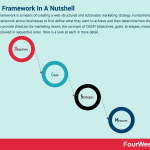
The OGSM framework is a means of creating a well-structured and actionable marketing strategy. Fundamentally, the OGSM framework allows businesses to first define what they want to achieve and then determine how they will get there. To provide direction for marketing teams, the acronym of OGSM (objectives, goals, strategies, measures) should be followed in sequential order. Here is a look at each in more detail.
Objectives
In the first step, the overall objective should be defined. The objective should be related to the purpose of the business, or its company mission and brand values. For example, a business that offers corporate wellness training might have the objective of creating content around a healthy work/life balance.
The marketing strategy may then seek to educate senior management on designing and implementing a wellness program across the entire organization.
Goals
To have a realistic chance of achieving the objective, it should be broken down into smaller goals. Importantly, the goals must be clear and concise and easily trackable.
The corporate wellness company might aim for 2,000 website visitors a month, with 15% of those purchasing the program through an email marketing campaign. Alternatively, the business may have a goal of directly contacting 300 other businesses per month and converting 5% of them to the wellness product.
Strategies
Strategies explain how the goals might be achieved. To convert the 15% of website users into paying customers, the corporate wellness company needs to think about developing a buyer persona, hiring a copywriter, and creating targeted landing pages – among other things.
Measures
Measures help ensure that a business is moving toward its goals in a timely fashion. In other words, measures are numerical benchmarks that use key performance indicators to provide guidance on strategy effectiveness.
The corporate wellness company might need six months of email marketing to convert enough clients to be profitable. If that number of clients is 600, then the business can set a measure of at least 100 new clients per month.
Advantages and disadvantages of the OGSM framework
Advantages
The OGSM framework is a short, simple, and concise one-page plan that is visible in the sense that it is easy to understand across all levels of an organization.Goals are explicitly linked to specific actions, which increases the chances that performance standards are met.If conditions in the market or within an organization change, the OGSM framework can be adapted to suit.
Disadvantages
In some cases, the framework requires a degree of upfront cooperation as stakeholders negotiate competing goals and interests.The OGSM framework also requires a large commitment of approximately 5 years, which may be unsuitable for businesses needing to react quickly to fluctuating internal or external factors.The framework is reliant on strong leadership to ensure buy-in from all relevant stakeholders.
Key takeaways:
The OGSM framework defines actionable marketing strategies with quantifiable success metrics.The OGSM framework is an acronym for objective, goals, strategies, and measures. As the business works through each step to create a strategy, the level of detail and specificity increases.The OGSM framework is effective and simple to understand. But it does require strong leadership over the log-term to keep stakeholders engaged and working toward a common goal.
Other strategy frameworks:
AIDA ModelAnsoff MatrixBalanced ScorecardBCG MatrixDesign ThinkingFlywheelLean Startup CanvasOKRPestel AnalysisTechnology Adoption CurveTotal Addressable Market
Additional resources:
Market SegmentationSuccessful Types of Business Models You Need to KnowThe Complete Guide To Business DevelopmentBusiness Strategy: Definition, Examples, And Case StudiesWhat Is a Value Proposition? Value Proposition Canvas ExplainedMarketing Strategy: Definition, Types, And Examples
The post What Is The OGSM framework And Why It Matters In Business appeared first on FourWeekMBA.
PESO Model And Why It Matters In Business
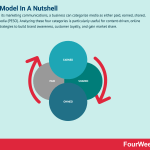
To optimize its marketing communications, a business can categorize media as either paid, earned, shared, or owned media (PESO). Analyzing these four categories is particularly useful for content-driven, online marketing strategies to build brand awareness, customer loyalty, and gain market share.
Understanding the PESO model
There is no more effective means of lead generation than online media. Businesses who use online media to their advantage build brand awareness, customer loyalty, and market share. To derive maximum value out of online marketing, however, brands must use a variety of strategies across different mediums.
These mediums encompass four categories of media. While each category will require professional strategies to be developed, it is important to note that the PESO model seeks to help each media channel act as a single, cohesive unit.
Let’s now look at them in more detail.
The four categories of online media
Paid media
Paid media is what most consumers associate with traditional advertising. Think print advertisements, TV commercials, or banner ads. In most cases, one business is buying access to the audience or platform of another business.
Paid media can be tracked through performance metrics such as clicks, conversions, visits, or views. It is a highly effective (though resource-intensive) form of advertising. But to maintain its efficacy, it does require continuous investment.
Earned media
Earned media is content that is created about a business by a separate entity, whether that be an individual or another business. Earned media is not paid media, in a sense that earned media results when a business does something worth talking about.
Earned media includes backlinks, press coverage, reviews, and awards. Because of its association with viral content, earned media has the potential to reach many more consumers than paid or owned media.
Shared media
Shared media is content shared across social media. It is a less explicit form of media since social media is a constantly evolving landscape.
Shared media includes social media content, but it also encompasses user-generated content and co-created partner content.
Owned media
As the name suggests, owned media is any type of media content that a business creates itself. This includes websites, videos, podcasts, e-books, and blog posts.
Owned media also includes content a business outsources to a freelancer – so long as the copyright is transferred from the freelancer to the business after completion.
The importance of integration in the PESO model
A fundamental concept of the PESO model is that each category is more effective when used in conjunction with other categories than it is in isolation.
Some businesses may be tempted to incorporate paid media as their only strategy, but this approach only works as long as funds continue to flow. However, paid media is important when a business has high quality owned media that it needs to showcase in front of a large audience.
Super Bowl advertisements are one example of this process in action. Brands use a combination of paid, shared, and owned media to generate buzz. This in return creates earned media, where brand awareness increases through organic referrals, backlinks, and press coverage.
Key takeaways:
The PESO model is a marketing strategy where businesses use a combination of paid, earned, shared, and owned media.The PESO model is used to increase brand awareness, customer loyalty, and market share.The PESO model is most effective as a holistic and fully integrated marketing strategy. While each media category is effective in isolation, integration ensures a stronger and more cohesive strategy that drives outcomes.
Other strategy frameworks:
AIDA ModelAnsoff MatrixBalanced ScorecardBCG MatrixDesign ThinkingFlywheelLean Startup CanvasOKRPestel AnalysisTechnology Adoption CurveTotal Addressable Market
Additional resources:
Market SegmentationSuccessful Types of Business Models You Need to KnowThe Complete Guide To Business DevelopmentBusiness Strategy: Definition, Examples, And Case StudiesWhat Is a Value Proposition? Value Proposition Canvas ExplainedMarketing Strategy: Definition, Types, And Examples
The post PESO Model And Why It Matters In Business appeared first on FourWeekMBA.
Perceptual Mapping In A Nutshell
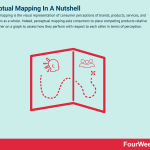
Perceptual mapping is the visual representation of consumer perceptions of brands, products, services, and organizations as a whole. Indeed, perceptual mapping asks consumers to place competing products relative to one another on a graph to assess how they perform with respect to each other in terms of perception.
Understanding perceptual mapping
For businesses, a clear understanding of how they are perceived by consumers is crucial to their success. So too is the perception of a business relative to its main competitors. These insights help businesses understand their target consumers and create useful products accordingly. These insights can also extend to identifying gaps in the market and staying ahead of market trends.
Perceptual mapping asks consumers to place competing products relative to one another on a graph. Examples of metrics that may be analyzed include:
Price vs quality.Price vs functionality.Tastiness vs health rating.Safety vs price.Performance vs price.
Creating a perceptual map
Most perceptual maps are two-dimensional charts displaying two axes – with each axis serving as a scale from low to high and representing one metric. Let’s assume for this example that the two metrics being analyzed are price and quality.
Once the metrics have been determined, the following steps include:
Brainstorming a list of products in a market. This allows businesses to identify the most common products and avoids bias.Placing each product on the map according to its price and quality values. In other words, a low quality, low price product will occupy a vastly different position than a higher quality, higher-priced product.Having marketers prepare a report on the outcomes to share with relevant stakeholders. Ideally, some products and companies will be judged on various attributes over multiple conceptual maps. This gives a more comprehensive view of the market and is of particular importance in highly fluid and dynamic market environments.
Perceptual mapping using qualitative and quantitative data
Perceptual maps may represent either qualitative or quantitative data, with each serving a different purpose.
Qualitative
Qualitative performance maps illustrate consumer perceptions of a brand, product, or service. Indeed, the attributes chosen for appraisal must come directly from individuals in the form of interviews and surveys.
If, for example, WordPress customers were interviewed about the attributes they valued most, they might consider user-friendliness and support to be the most important. A map could then be created to show how WordPress is positioned for these attributes when compared to main competitors Squarespace and Weebly.
Quantitative
Quantitative performance mapping deals with objective and measurable statistics. Here, attributes are based on empirical evidence and not on the subjective thoughts, feelings, and emotions seen in qualitative research.
Consider the example of a gas station trying to increase market share. It might determine that in-store discretionary purchase amount and average distribution cost per gallon are important competitive metrics.
In both qualitative and quantitative analyses, the business must understand the why of its positioning on the map. A business that ranks highly in certain attributes should double down on the strategies that got it there. Conversely, a business that ranks lowly should devise a strategy for improvement by looking at the strategies of relevant competitors.
Key takeaways:
Perceptual mapping is a graphic illustration of where a brand, product, or company is positioned with respect to its competitors.Perceptual mapping makes value judgments about certain attributes that a business deems relevant to market competitiveness.Perceptual mapping may analyze qualitative consumer sentiment over a product, or it may also utilize the empirical hard data found in quantitative market research.
Other strategy frameworks:
AIDA ModelAnsoff MatrixBalanced ScorecardBCG MatrixDesign ThinkingFlywheelLean Startup CanvasOKRPestel AnalysisTechnology Adoption CurveTotal Addressable Market
Additional resources:
Market SegmentationSuccessful Types of Business Models You Need to KnowThe Complete Guide To Business DevelopmentBusiness Strategy: Definition, Examples, And Case StudiesWhat Is a Value Proposition? Value Proposition Canvas ExplainedMarketing Strategy: Definition, Types, And Examples
The post Perceptual Mapping In A Nutshell appeared first on FourWeekMBA.
September 24, 2020
MECE Framework In A Nutshell
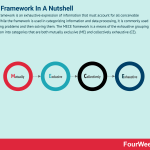
The MECE framework is an exhaustive expression of information that must account for all conceivable scenarios. While the framework is used in categorizing information and data processing, it is commonly used in formulating problems and then solving them. The MECE framework is a means of the exhaustive grouping of information into categories that are both mutually exclusive (ME) and collectively exhaustive (CE).
Understanding the MECE framework
The MECE framework argues that to understand and solve any large problem, potential factors must be sorted into two categories.
Mutually exclusive
Mutually exclusive means that each factor can only fit into one category at a time. In other words, there is no overlap.
Consider the example of a French cheese company, who is seeking to find the root cause of a problem with its distribution network. A framework that is not mutually exclusive may identify two items: distribution networks in France and camembert product distribution networks.
The reason for this lack of mutual exclusivity is that there is overlap between the two items. Since camembert is distributed in France, the item is counted twice.
Thus, a mutually exclusive problem may choose to analyze camembert distribution in France and camembert distribution in Italy. Here, there is no overlap between each item because they occupy different geographic areas.
Collectively exhaustive
Collectively exhaustive means that each factor covers all possible causes of a problem.
Returning to the cheesemaker with a distribution problem, simply looking at France and Italy is not collectively exhaustive. The company also exports to Spain and the UK, so assessing France and Italy in isolation may cause analysts to overlook the root cause of the problem.
Ultimately, the MECE framework allows businesses to investigate every potential cause in isolation. They do not have to worry that a specific cause may potentially influence the role of another cause in creating the same problem.
Five steps to developing a MECE hypothesis
Understand the problem in detail. What outcome does the business hope to achieve?Write down the problem statement, ensuring that there is no room for ambiguity. Then, list potential options (solutions) to the problem using a MECE idea tree. In the case of the cheesemaker, each option must be both mutually exclusive and collectively exhaustive.With a list of potential solutions illustrated on the idea tree, consider the pros and cons of each individually. Remove any that seem illogical or add new solutions gleaned from greater insight into the problem itself.Select the best option and then present it to internal or external stakeholders. At this stage, it’s important that the option is proven, not obvious, and can be performed with a set of predetermined actions.
Applications of the MECE framework
Several frameworks across various disciplines have MECE principles at their core, including the:
Cost-Benefit Analysis – which involves the systematic evaluation of the costs or benefits of a project, policy, or program. Porter’s Five Force Model – which is a powerful tool for understanding the competitiveness in a given industry.4C Model – a tool for analyzing workplace psychology using core components of motivational theory.
Key takeaways:
The MECE framework allows businesses to assess large amounts of information according to mutual exclusivity and collective exhaustion.The MECE framework forms the foundation of several other frameworks, but it is most commonly used in the rigorous and exhaustive solving of problems.Solutions to problems derived from the MECE framework must have proven effectiveness and be realistically achievable. Crucially, they must not be the first or most obvious solution encountered.
Other strategy frameworks:
AIDA ModelAnsoff MatrixBalanced ScorecardBCG MatrixDesign ThinkingFlywheelLean Startup CanvasOKRPestel AnalysisTechnology Adoption CurveTotal Addressable Market
Additional resources:
Market SegmentationSuccessful Types of Business Models You Need to KnowThe Complete Guide To Business DevelopmentBusiness Strategy: Definition, Examples, And Case StudiesWhat Is a Value Proposition? Value Proposition Canvas ExplainedMarketing Strategy: Definition, Types, And Examples
The post MECE Framework In A Nutshell appeared first on FourWeekMBA.
September 23, 2020
RFM Analysis And Why It Matters In Business
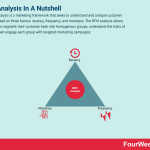
The RFM analysis is a marketing framework that seeks to understand and analyze customer behavior based on three factors: recency, frequency, and monetary. The RFM analysis allows businesses to segment their customer base into homogenous groups, understand the traits of each, and then engage each group with targeted marketing campaigns.
Understanding the RFM analysis
The RFM analysis differs from other methods such as demographic segmentation, where a customer base is targeted according to age, employment, gender, or other demographic data.
In the RFM analysis, the ultimate goal is to predict which consumers are most likely to make a repeat purchase.
To this end, individual consumers are segmented based on buyer behavior that includes:
Recency – the time elapsed since a customer bought or last engaged with a product.Frequency – expressed as the total number of transactions and engaged visits or the average time between transactions and engaged visits.Monetary – describing the intention of a customer to spend or their purchasing power. In other words, the total or average value of their transactions.
Implementing an RFM analysis for customer segmentation
When individual customers are scored according to RFM metrics, marketers gain valuable insight into buyer behavior. The analysis will clearly identify the customer who spends the most money on a business, but it also provides information on:
Customers who contribute most to churn rate, or the rate at which a customer stops doing business with an organization.Customers who have the potential to become valuable, repeat buyers.Customers who are most likely to respond to push notification marketing.
Ultimately, the RFM analysis tells a business where each consumer is in their buying journey. The journey will be specific to each individual and indeed each business, and it guides whether future offers should be made and when.
For example, a consumer who buys a pair of shoes with a high recency score and low frequency and monetary scores is likely a new customer. As a result, the shoe company might send them follow up emails with shoe care tips and maybe the cross-promotion of laces or inserts.
Conversely, a consumer who buys another pair of shoes with low recency, high frequency, and high monetary score is a high-spending though disengaged consumer. The shoe company might look at his purchase history to offer them a new pair of shoes at a price point they find attractive.
Industry-specific RFM analyses
Depending on the industry, a business should increase or decrease the relative importance of RFM values.
For example, a car dealership should place little importance on frequency – since new cars are not products that are bought monthly. Recency is a better metric, as the company can target previous buyers who are more likely to upgrade models.
In the consumer staples industry, frequency and recency are more important than monetary – because most discretionary items are low value and need to be replenished periodically.
Lastly, a not-for-profit charity organization should value the monetary and frequency component above all. This is because charities are reliant on periodic donations to survive.
Key takeaways:
The RFM analysis argues that recency, frequency, and monetary traits are the best predictors of consumer buying behavior.The RFM analysis can provide valuable insight into where consumers are in their journeys, which in turn dictates the most effective marketing strategies.Depending on the industry and the nature of purchasing decisions, certain metrics in the RFM analysis should be given more weight than others.
Other strategy frameworks:
AIDA ModelAnsoff MatrixBalanced ScorecardBCG MatrixDesign ThinkingFlywheelLean Startup CanvasOKRPestel AnalysisTechnology Adoption CurveTotal Addressable Market
Additional resources:
Market SegmentationSuccessful Types of Business Models You Need to KnowThe Complete Guide To Business DevelopmentBusiness Strategy: Definition, Examples, And Case StudiesWhat Is a Value Proposition? Value Proposition Canvas ExplainedMarketing Strategy: Definition, Types, And Examples
The post RFM Analysis And Why It Matters In Business appeared first on FourWeekMBA.
Value Disciplines Model In A Nutshell
The Value Disciplines Model was developed by authors Michael Treacy and Fred Wiersema. In their model, the authors use the term value discipline to represent any method a business may use to differentiate itself. The Value Disciplines Model argues that for a business to be viable, it must be successful in three key areas: customer intimacy, product leadership, and operational excellence.
Understanding the Value Disciplines Model
After researching successful companies such as Dell and Sony, the authors, Michael Treacy and Fred Wiersema proposed that a business must be competent in the three key areas mentioned at the outset. Importantly, businesses who aspire to be market leaders must also excel in one of the key areas.
The three key areas of the Value Disciplines Model
Customer intimacy
Customer intimacy encompasses customer service and customer attention. To excel, a business must wherever possible personalize customer service. It must also develop a range of customizable products that meet different customer needs in great detail.
The customer service team of shoe company Zappos not only keep their customers happy but also surprise them too. When a best man ordered shoes from Zappos for a wedding that were later lost in postage, the company overnighted a new pair of shoes to him and gave a full refund anyway.
Product leadership
Product leadership means that a business offers products that are market leaders. This often requires a large investment in research and development, but the rewards are obvious. Leadership is easier said than done. It requires creative thinking and a rapid commercialization process to beat the competition. Products must also be continually updated to avoid obsolescence.
Apple’s continued devotion to innovation and product updates has seen then remain as leaders in the tech space for decades.
Operational excellence
In the context of the Value Disciplines Model, operational excellence means a focus on price and convenience. This means that a business should focus on removing common barriers that prevent a consumer from making a buying decision.
Dell was able to become market leaders in desktop computers by offering computers delivered to order rather than to inventory. This removed the middleman and reduced costs without sacrificing the product or service.
Limitations to the Value Disciplines Model
While adequate performance in each of the three areas is relatively easy, businesses will find becoming a market leader by excelling in one area much more difficult.
For smaller businesses, there is the potential that they become disheartened at a rather binary approach to success. Newer businesses might also become disillusioned at the broad and generic definitions of success – particularly if these businesses do not have sufficient data to gauge success.
Key takeaways:
The Value Disciplines Model defines success in the context of three generic value disciplines: customer intimacy, product leadership, and operational excellence.Success in the Value Disciplines Model can be broadly measured by the degree of cost-effectiveness, product or service quality, and organizational performance.The Value Disciplines Model is a long term strategy that requires a certain level of maturation in a business. Without a solid understanding of their industry and a lack of resources, some may find it difficult to define and then achieve market leadership.
Other strategy frameworks:
AIDA ModelAnsoff MatrixBalanced ScorecardBCG MatrixDesign ThinkingFlywheelLean Startup CanvasOKRPestel AnalysisTechnology Adoption CurveTotal Addressable Market
Additional resources:
Market SegmentationSuccessful Types of Business Models You Need to KnowThe Complete Guide To Business DevelopmentBusiness Strategy: Definition, Examples, And Case StudiesWhat Is a Value Proposition? Value Proposition Canvas ExplainedMarketing Strategy: Definition, Types, And Examples
The post Value Disciplines Model In A Nutshell appeared first on FourWeekMBA.
September 22, 2020
Kapferer Brand Identity Prism In A Nutshell
Developed in 1986, the prism has become a major contributor to the importance of storytelling in brand development and consumer awareness. The Kapferer Brand Identity Prism is a framework for clarifying brand identity through six different brand characteristics. Those comprise physique, personality, culture, relationship, reflection, and self-image.
Understanding the Kapferer Brand Identity Prism
To provide a more holistic depiction of brand identity, management consultant Jean-Noel Kapferer developed six core elements – with each illustrated as one corner of a prism.
Over thirty years later, Kapferer’s model remains a valuable means of creating a brand that reflects the core values of a business.
In the next section, we’ll look at each of the six elements in more detail.
The six elements of the Kapferer Brand Identity Prism
Kapferer argues that brand success is driven by the company-wide adoption of six elements.
Physique
This describes the physical characteristics of a brand, most often represented in a logo, iconography, and color palette. It also extends to the physical form of products and services. Physique is considered the basis of a good brand because it dictates how that brand is perceived among consumers.
In other words, what emotions does a brand inspire and how it can physically embody those emotions? For example, Nike’s dynamic swoosh evokes confidence, joy, energy, and exuberance.
Personality
Personality is the voice of a brand, dictating what a brand says and how the brand should say it. Importantly, personality is not limited to verbal communication. It also includes such things as font choices, communication tone, design, and copywriting.
With bold color choices and a scripted font, Coca-Cola is perceived as a happy-go-lucky person who is the life of the party.
Culture
It may surprise some that internal culture is also an important part of brand identity. Google’s culture as a flexible and creative workplace is reflected in their products and services. Tesla’s culture of innovation was created by an internal culture where employees are encouraged to share their new ideas.
Relationship
Relationship encompasses the engagement that occurs between brand and consumer. Here, engagement does not mean money changing hands. Instead, it looks at how a brand maintains a positive association with its target audience by exceeding their expectations.
Apple’s unwavering focus on usability and exemplary customer service has earnt them an unbreakable relationship with millions of customers.
Reflection
Reflection in brand identity describes the depiction of a target audience or buyer persona in brand advertising. Some brands like Coca-Cola appeal to a wide range of buyer personas because its fun and playful personality attracts consumers across a wide demographic.
In a more specific approach, Marlboro and their strong, masculine, cowboy-themed promotions sought to target smokers who displayed similar traits.
Self-image
Self-image encompasses the feeling a consumer wants to receive after interacting with a brand – usually via a purchase. Businesses should aim to determine the aspirations, goals, and values of the target audience – and then seek to embody these characteristics. When a consumer purchases a luxury car, for example, they are buying because of the status and prestige of the branded badge on the hood.
Completing the Kapferer Brand Identity Prism
Once the six elements have been clarified, they are then divided into four broader categories:
Picture of sender – or the way that a brand presents itself. Physique and Personality fall under this category.Picture of receiver – or the way that consumers see a brand. Reflection and Self-Image belong in this category.Externalization – or all visible brand outputs such as logo and advertising, best represented by Relationship.Internalization – or internal brand drivers that represent Culture – such as values, history, leadership, and human resources.
Key takeaways:
The Kapferer Brand Identity Prism identifies six elements that compose brand identity: physical elements, personality, culture, relationship, reflection, and self-image. The Kapferer Brand Identity Prism focuses on the storytelling aspect of brand development and is comprised of evergreen marketing principles that have been relevant in business for decades.Ultimately, the Kapferer Brand Identity Prism is a complete and precise means of brand formation for businesses who want to communicate to their target audience in a highly personalized manner.
Other strategy frameworks:
AIDA ModelAnsoff MatrixBalanced ScorecardBCG MatrixDesign ThinkingFlywheelLean Startup CanvasOKRPestel AnalysisTechnology Adoption CurveTotal Addressable Market
Additional resources:
Market SegmentationSuccessful Types of Business Models You Need to KnowThe Complete Guide To Business DevelopmentBusiness Strategy: Definition, Examples, And Case StudiesWhat Is a Value Proposition? Value Proposition Canvas ExplainedMarketing Strategy: Definition, Types, And Examples
The post Kapferer Brand Identity Prism In A Nutshell appeared first on FourWeekMBA.
What Is The Hanlon’s Razor And Why It Matters In Business
Hanlon’s razor is an adage, often quoted as such:
“Never attribute to malice that which is adequately explained by stupidity.”
In other words, there is a tendency for individuals or businesses to assume malice when that malice is in fact stupidity.
Understanding Hanlon’s razor
Variations of Hanlon’s razor go back as far as German writer Johann Wolfgang von Goethe, who equated malice and stupidity with incompetence. However, the adage was named after Robert J. Hanlon, who submitted the quote for inclusion in a joke book.
In the modern context, Hanlon’s razor is a somewhat philosophical concept. Indeed, the principle of a razor in philosophy is one that allows the individual to eliminate or “shave off” unlikely explanations for a particular phenomenon.
When Hanlon’s razor is not taken into account, the individual or business who has a bad experience assumes that the world is against them. That the world or the individuals it consists of are malicious and intent on doing them harm.
Instead, Hanlon’s razor advocates that problems and bad experiences are part of life. In the vast majority of instances, there is no malice behind them.
In marketing and business relationships, Hanlon’s razor is one of a suite of mental models that govern specific thought processes attached to examining a problem.
Examples of Hanlon’s razor in business
British Airways
When British Airways experienced an IT shutdown in 2017 that affected 75,000 passengers, consumers widely assumed that the airline was acting against them.
Theories ranged from budget cuts to the outsourcing of work to India, or a combination of both. However, the shutdown was later determined to have been caused by a simple power malfunction.
Apple
There is a widespread belief that Apple tries to force people to upgrade to the latest iPhone by slowing the performance of older models.
Yet Apple revealed that the slower performance was due to an update that decreased the load on older batteries and thus their tendency to cause these older model smartphones to crash.
The benefits of Hanlon’s razor thinking
Improved relationships. Say for example that a potential joint venture partner does not return a business’s calls. The business could assume the worst and conclude that the other party is acting maliciously toward them – souring the relationship in the process. Alternatively, the business who practices patience may receive a phone call in a few days explaining that a family member was taken ill and that the partner was still looking forward to a joint venture in the future. Better resource allocation. Instead of spending time and money planning for the worst-case scenario, businesses can divert resources to the less malicious (though far more likely) cause of a bad experience. This encourages fact-based decision making, which investor Charlie Munger advocates as essential to dismantling and then solving business problems that can often be governed by emotion.
Key takeaways:
Hanlon’s razor argues that in most cases, it is better to assume that a negative event occurred because of stupidity or incompetence rather than malice.Hanlon’s razor is one of several mental models of thinking that businesses can use. It advocates a fact-based decision making response to internal or external negative events.The benefits of Hanlon’s razor include better relationships with key stakeholders and smarter problem-solving resource allocation.
Other strategy frameworks:
AIDA ModelAnsoff MatrixBalanced ScorecardBCG MatrixDesign ThinkingFlywheelLean Startup CanvasOKRPestel AnalysisTechnology Adoption CurveTotal Addressable Market
Additional resources:
Market SegmentationSuccessful Types of Business Models You Need to KnowThe Complete Guide To Business DevelopmentBusiness Strategy: Definition, Examples, And Case StudiesWhat Is a Value Proposition? Value Proposition Canvas ExplainedMarketing Strategy: Definition, Types, And Examples
The post What Is The Hanlon’s Razor And Why It Matters In Business appeared first on FourWeekMBA.



